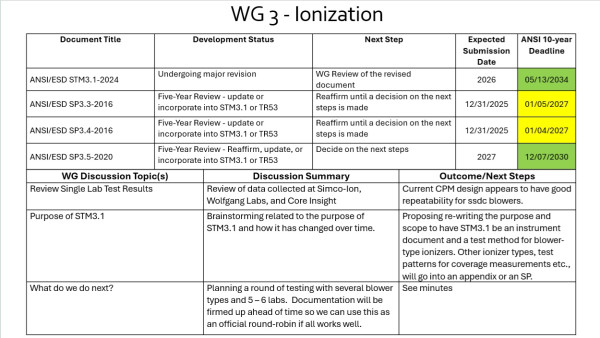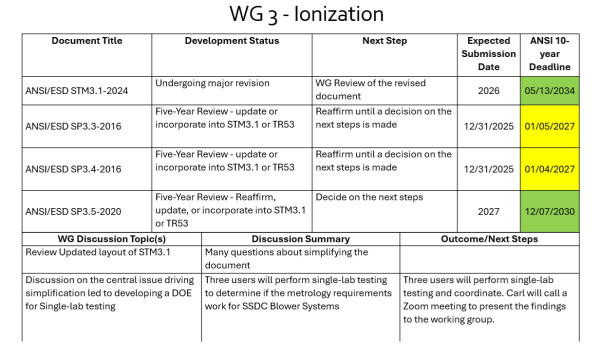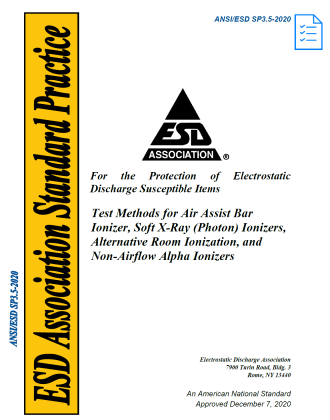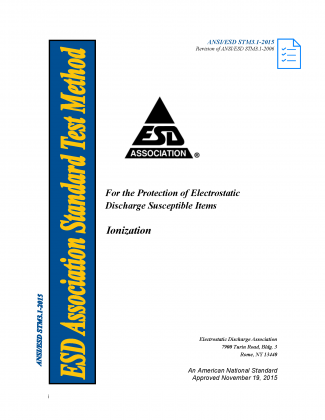WG 3.0 – Ionization
- Status:
- Active
- Working Group Chair:
- Co-Chairs: Carl Newberg, Simco-Ion, Technology Group; Charles McClain, Micron Technology, Inc.
-

-

-

-
Summary of discussions/activities/document reviews during the most recent WG meeting:
- ANSI/ESD STM3.1 has been released after being re-affirmed.
- A review of a proposed layout with some new layout structures was reviewed. Comments from the working group indicated that a more simplistic approach may be required since this is a “Qualification Test Method Document.”
- A small investigation group to look at the metrology portion of the document was developed and will work offline to address this concern.
-
The group discussed the reaffirmation of STM3.1, stating it would be published in the coming weeks. They also addressed concerns about moving periodic verification information into TR53 but didn't resolve the issue. The withdrawal of SP3.3 & 3.4 was postponed until the rewrite of STM3.1 is completed. Additionally, a proposal to simplify the layout of STM3.1 was reviewed.
-
The committee reviewed the proposed strategy for realigning ionization documents. The group provided feedback on the proposed "in-tool" blower test method and addressed related questions. The WG started reviewing a revised STM3.1 document, discussing the limitations of current test equipment and the importance of advancing toward better equipment. The group reviewed the layout of the new document.
-
The WG agreed to submit the existing version of ANSI/ESD STM3.1 for re-affirmation while working on a major revision to the document. The WG also agreed that the structure of the suite of 3.0 documents needs to be revised – many documents need revision/renaming etc. Sections of the SPs with compliance verification need to be moved to TR53.
The agenda may change based on my meeting with TAS on Monday, but this is a rough set of goals.
-
WG adjudicated STDCOM comments on ESD WIP3.1 – Ionization and addressed all should vs. shall statements – except for reporting requirements.
Discussion on reporting requirements:
- Generally, poorly defined requirements for reporting.
- Lengthy discussion on offset voltage - discharge time doesn’t specify reporting requirements.
- Recommend adding a section for each type of ionizer, while aligning with ‘Minimum Reporting Requirements’.
-
The WG reviewed the STDCOM comments on WIP3.1, “Ionization”, adjudicating some comments. Comments will be returned to headquarters once the adjudication process is complete.
-
WG focused on the review of STDCOM comments on ANSI/ESD SP3.4 “Periodic Verification of Air Ionizer Performance Using a Small Test Fixture” and made any necessary changes. ANSI/ESD STM 3.1, “Ionization”, is also going through an update process, with initial STDCOMV VBM comments being reviewed and changes being made.
-
The WG finished adjudicating TAS comments on ESD WIP3.4 during the five-year review. The document will be submitted to STDCOM vote before the September meeting.
-
WG focused on the review of the TAS comments on STM3.4 “Periodic Verification of Air Ionizer Performance Using a Small Test Fixture”. Document is going through an update on the 2016 version.
STM 3.1, “Ionization” is also going through an update process with initial Industry Review comments being reviewed and changes being made.
-
The committee adjudicated TAS comments on the five year review revisions to ANSI/ESD STM3.1. The WG also continued reviewing ANSI/ESD SP3.3 and a demo on ION master was presented.
-
The committee reviewed final updates to ANSI/ESD STM3.1 during the five-year review cycle. The document will be submitted for TAS review before the next meeting series. The group also drafted a new definition for peak offset voltage that will be sent to TAS for review.
-
The committee reviewed a proposed new annex for ANSI/ESD STM3.1 on CPM performance related to high-frequency ionization.
-
Summary of meeting activities:
The committee reviewed the new WG3 SharePoint Site. The committee also reviewed the status of ANSI/ESD SP3.5 which was published in January 2021. The group also continued working on the five-year review of ANSI/ESD STM3.1.

